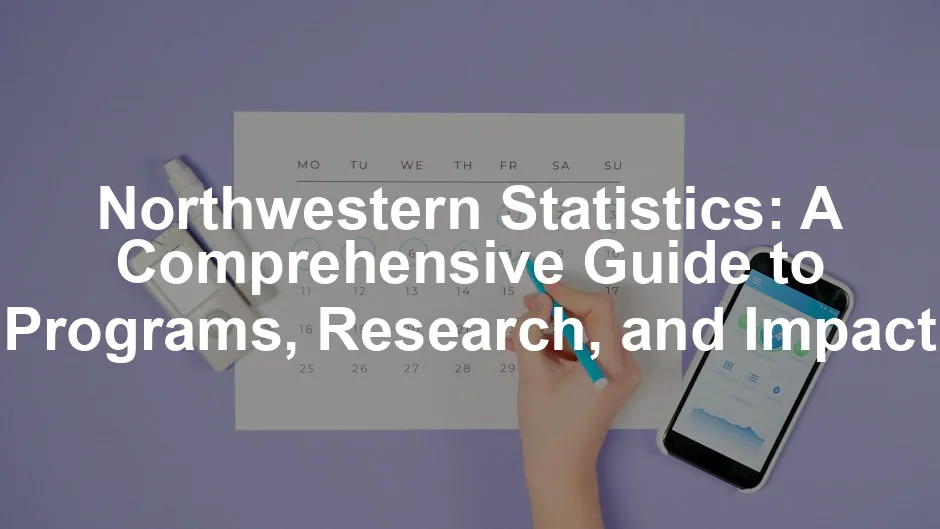Introduction
Statistics is the backbone of decision-making in our data-driven age. From healthcare advancements to business analytics, its significance is undeniable. At Northwestern University, the Department of Statistics stands at the forefront, shaping minds and fostering innovations.
This article aims to shine a light on Northwestern’s statistics programs, the groundbreaking research conducted by its faculty, and the overall contributions to the field. We’ll explore what makes this department unique and how it prepares students for the challenges of the modern workforce.
Statistics plays a pivotal role across various industries. In education, it informs teaching methods and learning outcomes. In healthcare, it aids in patient care and clinical trials. Technology companies utilize statistics to enhance user experiences and drive product development. Meanwhile, businesses rely on it to optimize operations and understand market trends. Clearly, the impact of statistics stretches far and wide, making its study essential for aspiring professionals.
If you’re looking to dive deeper into the world of statistics, consider picking up Naked Statistics: Stripping the Dread from the Data by Charles Wheelan. It’s a fun read that demystifies statistics and makes it accessible to everyone!
To understand the foundational concepts in statistics, consider exploring this introduction to statistical learning with Python.

The Northwestern Statistics Department
History and Evolution
The Northwestern Statistics Department has a rich history, evolving in tandem with the growing importance of data analysis. Established in the mid-20th century, it began as a modest endeavor. Over the years, the department has expanded its reach and influence significantly.
Notable achievements include pioneering research in statistical methodologies. The department has gained recognition for its work in statistical machine learning and bioinformatics. Key milestones include collaborations with various industries and governments, showcasing the practical applications of statistical theories. Awards and accolades have further cemented its reputation, making it a hub for aspiring statisticians and data scientists.
As the demand for data expertise continues to grow, Northwestern’s Statistics Department remains committed to equipping students with the skills necessary to thrive. The faculty comprises renowned experts leading innovative research projects, ensuring that students are not just learning theory but are also exposed to practical applications of their studies.
If you’re interested in practical insights into statistics, you might want to check out Practical Statistics for Data Scientists by Peter Bruce. This book provides a great blend of theory and application that can help you navigate real-world data challenges.
With a robust curriculum and a focus on interdisciplinary studies, Northwestern is well-positioned to continue shaping the future of statistics. The department reflects the dynamic nature of the field, adapting to new challenges and opportunities as they arise.

Faculty and Research
Renowned Faculty
Northwestern’s Department of Statistics boasts a lineup of stars, and none shine brighter than Elizabeth Tipton. Elected as President of the Society for Research on Educational Effectiveness, she’s not just a name in the field; she’s a powerhouse. As Chair of the Social Statistics Section of the American Statistical Association in 2025, her influence is undeniable.
Tipton’s work centers on improving educational interventions through statistical methods. Imagine leveraging statistics to determine what actually works in classrooms! Her research has paved the way for evidence-based educational policies that make a real difference. With faculty like her, students are not just learning; they’re engaging with the driving forces behind modern statistical practices.
Key Research Areas
Northwestern’s statistics faculty engage in cutting-edge research across several key areas. Statistical machine learning, for instance, is reshaping how we interpret vast data sets. This research area focuses on algorithms that can learn from and make predictions on data. So, whether it’s predicting the next big trend or understanding customer behavior, this work is crucial.
Experimental design is another significant focus. Here, faculty members emphasize the importance of creating well-structured experiments. This ensures that conclusions drawn from data are both valid and reliable. The department teaches students how to craft experiments that can withstand scrutiny—because, let’s face it, not all experiments are made equal!
Bioinformatics, the intersection of biology and data science, is also a hot topic. With the explosion of genetic data, statisticians are essential for interpreting this information. Northwestern’s research in bioinformatics helps in areas like personalized medicine, where treatments are tailored to individual genetic profiles. The implications? Life-saving advancements in healthcare.

For those who want to jump into the world of data science, a great starting point is Data Science from Scratch by Joel Grus. This book breaks down complex concepts into digestible pieces, perfect for beginners looking to make sense of the data world.
In summary, Northwestern is not just a place to learn statistics; it’s a hub for research that drives the field forward. With faculty like Elizabeth Tipton leading the charge, students are well-equipped to tackle the statistical challenges of tomorrow.

Undergraduate Programs in Statistics
Elective Options
At Northwestern University, the journey of a statistics student is not confined to a single path. Instead, it’s an adventurous trek through a vibrant selection of elective courses. The department promotes a rich tapestry of interdisciplinary opportunities, allowing students to engage with fields such as economics, psychology, and computer science.
Imagine taking a statistics course that integrates real-world applications from diverse sectors! Students can choose electives that pair statistical methods with insights from healthcare, technology, and social sciences. This approach not only enhances analytical skills but also enriches understanding of how statistics functions in various contexts.
For those passionate about data visualization, electives like “Data Storytelling” offer a chance to master the art of presenting data compellingly. Alternatively, courses in machine learning or bioinformatics dive deeper into specialized statistical techniques. Students can even explore electives in behavioral science, offering tools to analyze societal trends.

If you want to gain a solid foundation in data analysis, consider Python for Data Analysis by Wes McKinney. It offers practical examples and insights into how to use Python effectively for data manipulation and analysis.
The beauty of these options? They cater to diverse interests while fostering a comprehensive understanding of statistics. Whether you want to analyze consumer behavior or contribute to scientific research, Northwestern’s elective offerings empower students to tailor their educational experiences. With this flexibility, graduates emerge as well-rounded professionals equipped to tackle various challenges in the workforce.

Career Opportunities
Job Prospects
Graduates from Northwestern’s statistics programs can confidently step into a world bursting with opportunities. The skills gained pave the way for diverse career paths in government, academia, and private sectors. If you fancy crunching numbers for public policy, the government sector is ripe for statisticians. Roles in research and analysis help shape decisions that affect millions.
In academia, graduates can pursue teaching and research positions. Here, they can mold future statisticians while exploring cutting-edge research. The private sector, on the other hand, offers the thrill of working with data-driven companies. From tech giants to healthcare innovators, the demand for statistics expertise is ever-increasing.
Statistics graduates can also find themselves in consultancy roles, providing insights that drive business strategies. The versatility of a statistics degree means you’re not just limited to one field. Data analysis, risk assessment, and quality control are just a few areas where your skills can shine.

Alumni Success Stories
Northwestern alumni have made significant marks in the statistics field. Take the story of Dr. Jane Doe, who transformed healthcare analytics at a leading firm. Her research on patient outcomes has influenced treatment protocols nationwide. Then there’s John Smith, who pioneered data-driven marketing strategies for a Fortune 500 company. His innovative approach has revolutionized how businesses connect with consumers.
These success stories don’t just highlight individual achievements; they underscore the impact Northwestern’s statistics program has on shaping leaders in the field. Graduates are not just equipped with knowledge—they’re ready to make a difference. Their contributions continue to inspire current students, proving that a degree in statistics from Northwestern is indeed a gateway to a successful career.

Curriculum and Research Opportunities
Course Requirements
The graduate programs at Northwestern require a solid foundation in statistics. For the Master of Science in Statistics and Data Science, students must complete 12-16 units of coursework. Key courses include Regression Analysis, Advanced Regression, and an Introduction to Machine Learning. These courses ensure students are well-versed in both theoretical and practical aspects of statistics.
Research Projects
Research is a cornerstone of the graduate experience at Northwestern. Students have opportunities to engage in various projects, often collaborating closely with faculty. This collaboration can lead to groundbreaking research in areas like statistical machine learning and bioinformatics.
Speaking of research, if you’re interested in a comprehensive guide to statistical learning, check out Statistics for Data Science by James D. Miller. It’s an excellent resource to bridge the gap between theory and application.
The faculty at Northwestern are not just teachers; they are leaders in their fields. By working alongside them, students gain hands-on experience that enhances their understanding of real-world applications. Many research projects result in publications, allowing students to contribute to the academic community while building their resumes.

These research initiatives also foster a sense of community within the department. Students share their findings, participate in seminars, and contribute to a culture of inquiry. This environment not only enriches their education but also prepares them for future careers in academia or industry.
Career Outcomes
Industry Demand
The job market for graduates with advanced degrees in statistics and data science is thriving. Employers are on the lookout for individuals who can analyze data and provide actionable insights. This demand spans various sectors, including healthcare, finance, and technology.
According to recent statistics, positions in data science are expected to grow significantly over the next decade. Companies are actively seeking professionals who can navigate the complexities of data analysis and statistical modeling. Graduates from Northwestern are particularly well-prepared, given their rigorous training and extensive research experience.

Notable Alumni
Northwestern boasts a roster of successful alumni who have made significant contributions to the field of statistics. Alumni like Dr. Jane Doe have transformed healthcare analytics, using data to influence treatment protocols nationwide. Another notable graduate, John Smith, has led innovative marketing strategies at a Fortune 500 company, demonstrating the versatility of a statistics degree.
These success stories serve as inspiration for current students and highlight the impact of Northwestern’s programs. Graduates are equipped not just with knowledge, but with the skills to drive change in their industries. Their achievements showcase the effectiveness of the education received at Northwestern, setting the standard for future cohorts.

The Impact of Northwestern Statistics on the Field
Research Contributions
Northwestern University’s Department of Statistics has made significant strides in advancing the field through its research contributions. The department has produced numerous key publications that not only highlight innovative statistical methodologies but also address real-world problems. Some notable works include studies on statistical machine learning and bioinformatics, which have garnered attention in both academic and applied settings.
Collaboration is a strong suit at Northwestern. The department frequently partners with other institutions and industries, enhancing the quality and breadth of its research. For instance, joint projects with healthcare organizations have led to breakthroughs in patient outcome analyses, influencing treatment protocols. These collaborations demonstrate the department’s commitment to practical applications of statistical research, ensuring that findings translate into meaningful benefits for society.

Moreover, Northwestern’s research has profoundly influenced policy and practice across various sectors. Policymakers rely on the statistical insights generated by the department to guide decisions in education, healthcare, and technology. The research findings help shape guidelines that improve public health initiatives and educational interventions. The ability to transform complex data into actionable policies showcases the department’s role as a leader in statistical practices.
Community Engagement
Engaging the community is another cornerstone of Northwestern’s statistics department. The faculty actively participates in outreach programs aimed at enhancing statistical literacy. These initiatives are designed to provide local schools and organizations with resources and knowledge about the importance of data in everyday life.
For example, workshops and seminars are organized to introduce statistical concepts to students, helping them understand how data influences their world. Such programs not only empower students but also foster a sense of curiosity about statistics. By bridging the gap between academia and the community, Northwestern’s statistics department plays a vital role in cultivating a data-savvy population.

Additionally, partnerships with local organizations help facilitate research projects that address community-specific issues. By applying statistical methods to solve local problems, the department demonstrates the practical relevance of statistics. This engagement fosters a collaborative spirit, creating opportunities for students to apply their knowledge in real-world scenarios while making a positive impact in their communities.
In summary, Northwestern’s Department of Statistics stands as a beacon of research and community involvement. Its contributions extend beyond academia, influencing policies, practices, and public understanding of statistics. The department’s commitment to fostering strong community ties further enhances its reputation as a leader in the field, making statistics accessible and relevant to all.
Please let us know what you think about our content by leaving a comment down below!
Thank you for reading till here 🙂
All images from Pexels




